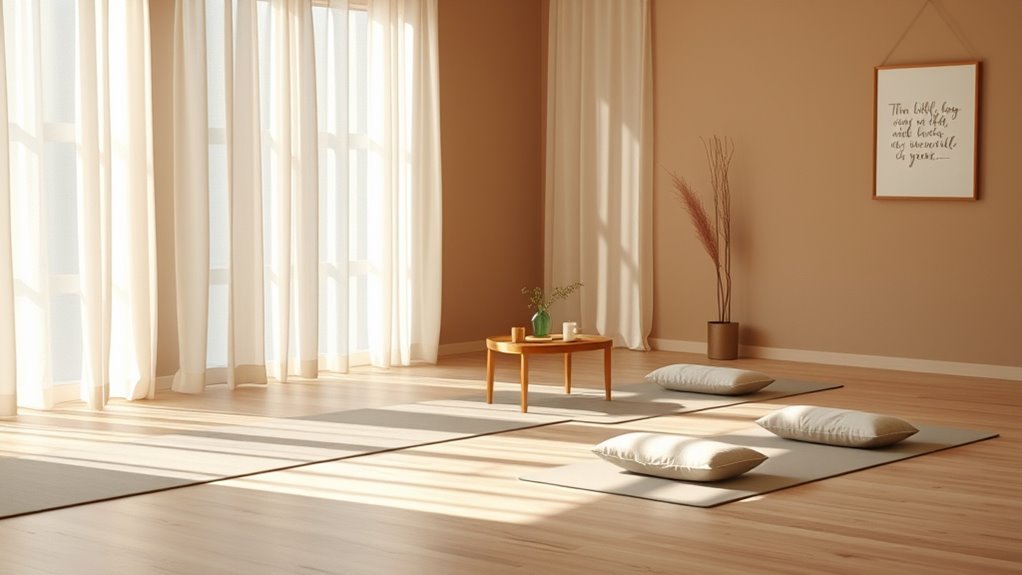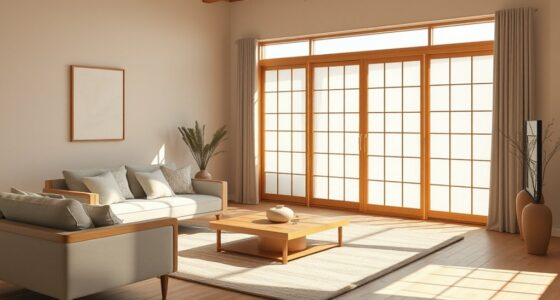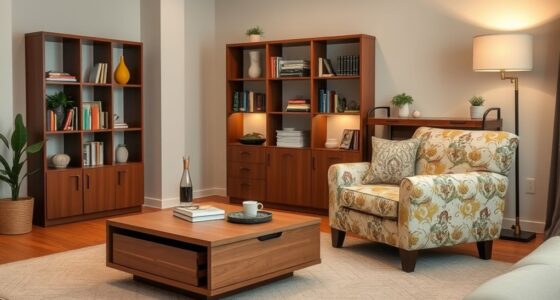Create a peaceful yoga or meditation space by selecting a quiet, clutter-free corner with a view of nature or outdoor elements. Use calming, neutral colors like beige or soft green, and incorporate natural materials such as wood or stone. Maximize natural light with windows or skylights, and layer soft, dimmable lighting for warmth in the evenings. Keep the area organized with vertical storage, and add plants or small water features to enhance positive energy. Discover how these design ideas can transform your space.
Key Takeaways
- Choose a quiet, clutter-free area with natural light and a view of nature to promote tranquility.
- Use calming neutral colors and layered lighting, including dimmable fixtures, to create a serene atmosphere.
- Incorporate natural materials like wood and plants to enhance harmony and positive energy flow.
- Arrange furniture based on feng shui principles, ensuring a commanding position and avoiding sharp corners.
- Keep the space organized with storage solutions for mats, cushions, and accessories to support openness and mindfulness.

Creating home wellness space is a powerful way to promote relaxation and balance in your daily life. When creating a dedicated area for yoga and meditation, paying attention to feng shui principles can markedly enhance the energy flow, making your space more calming and inviting. Start by positioning your room in a quiet, clutter-free part of your home, ideally with a view of nature or a calming outdoor element. Use feng shui to select the best placement for your furniture and accessories, avoiding sharp corners pointed toward your sitting area or bed, which can create stagnation or negative energy. Incorporate natural materials, such as wood or stone, to reinforce harmony and grounding within your space. Regularly assessing and rotating items in your wellness area can help maintain a balanced and harmonious environment.
Lighting techniques are essential in transforming your wellness room into a sanctuary of serenity. Opt for soft, layered lighting that can be adjusted throughout the day to match your mood and activity. Natural light is ideal, so position your space near windows or install skylights to maximize sunlight, which boosts mood and vitality. During evening hours or on cloudy days, supplement with warm LED lights or Himalayan salt lamps to create a soothing ambiance. Avoid harsh fluorescent or overly bright lighting, as it can disrupt your relaxation and hinder your ability to unwind. Dimmable fixtures give you control over the atmosphere, helping you transition smoothly from activity to stillness.
Color choices also influence the energy in your yoga or meditation room. Stick to calming, neutral tones like soft whites, beiges, or gentle earth hues that promote tranquility. Accents in subtle shades of blue or green can further enhance feelings of peace and balance. Keep your space clutter-free to maintain a sense of openness, which is essential for good energy flow according to feng shui. Use storage solutions to keep your mats, blocks, and meditation cushions neatly organized, preventing distractions and creating a clean, harmonious environment. Incorporating vertical storage solutions can also maximize space and keep your environment tidy.
Adding elements inspired by feng shui, such as small water features or plants, can also cultivate positive energy. Live plants improve air quality and bring a sense of vitality, while carefully placed water features symbolize flow and abundance. Be mindful of your room’s overall layout, ensuring that your sitting or lying area faces a commanding position, giving you a sense of control and stability. By combining mindful placement, thoughtful lighting, and harmonious colors, you create a dedicated space that nurtures your well-being. Your home wellness room becomes more than just a physical area—it transforms into a sanctuary where relaxation, mindfulness, and vitality thrive.
Frequently Asked Questions
What Is the Ideal Size for a Yoga or Meditation Room?
You should aim for a yoga or meditation room that’s at least 120 square feet to comfortably move and sit. Make sure good room ventilation to keep the space fresh and calming. Incorporate smart storage solutions to keep clutter out of sight, maintaining a peaceful environment. A slightly larger space allows for added props or accessories, enhancing your practice without feeling cramped. Prioritize comfort and airflow for the best experience.
How Can I Ensure Privacy in My Wellness Space?
To guarantee privacy in your wellness space, you should focus on soundproofing techniques and window treatments. Use thick rugs, wall panels, or weatherstripping to reduce noise, and install blackout curtains or layered window treatments to block visual distractions. These steps create a peaceful, secluded environment, fostering focus and relaxation. Prioritize these strategies to turn your space into a private retreat, shielding you from external disturbances and enhancing your mindfulness practice.
What Are the Best Lighting Options for Relaxation?
You should opt for ambient lighting to create a calming atmosphere in your wellness space. Dimmable options are ideal because they let you adjust the brightness to suit your mood and activity. Soft, warm tones help promote relaxation, so consider using warm LED bulbs or salt lamps. Avoid harsh, bright lights, and instead, focus on gentle illumination that encourages tranquility and mindfulness during your yoga or meditation sessions.
How Do I Choose Non-Slip Flooring Materials?
Remember, safety first. To choose non-slip flooring, prioritize materials with excellent durability and safety features, like cork, rubber, or textured vinyl. These options provide traction even when wet and withstand daily wear. Always check the flooring’s slip-resistance rating and verify it’s suitable for your space’s moisture levels. By selecting the right material, you create a secure, comfortable environment that supports your wellness practices and lasts over time.
What Are Eco-Friendly Decor Ideas for Wellness Rooms?
You can use eco-friendly decor ideas by incorporating sustainable materials like bamboo or reclaimed wood, which add natural charm and reduce environmental impact. Opt for natural color palettes with earthy tones such as soft greens, warm browns, and muted beiges to create calming, harmonious spaces. Incorporate organic textiles, biodegradable candles, and plants to enhance the wellness atmosphere while staying eco-conscious. These choices promote sustainability and a peaceful, grounding environment in your wellness room.
Conclusion
Designing your dedicated detox space isn’t just about decor; it’s about creating a calming corner for clarity and calm. With thoughtful touches, tranquil tones, and intentional organization, you’ll craft a cozy, conscious retreat that revitalizes your routine. Remember, your wellness space is where peace and purpose come together—making mindfulness a manageable, meaningful part of your daily life. So, set the scene, settle in, and let serenity shape your sanctuary. Your serene space awaits!









